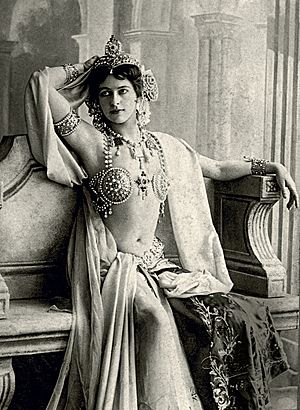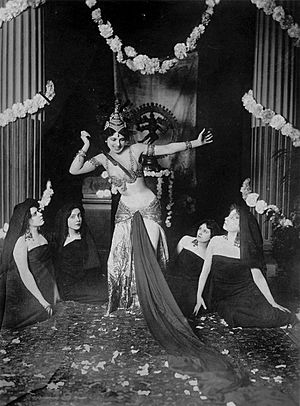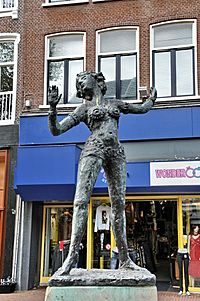Mata Hari facts for kids
Quick facts for kids Mata Hari |
|
|---|---|

Mata Hari circa 1910
|
|
| Allegiance | France, Germany |
| Service | Deuxième Bureau |
| Active | 1916–1917 |
|
|
|
| Birth name | Margaretha Geertruida Zelle |
| Born | 7 August 1876 Leeuwarden, Netherlands |
| Died | 15 October 1917 (aged 41) Vincennes, French Third Republic |
| Cause of death |
Execution by firing squad |
| Nationality | Dutch |
| Parents | Adam Zelle (father) Antje van der Meulen (mother) |
| Spouse |
Rudolf John MacLeod
(m. 1895; div. 1906) |
| Children | 2 |
| Occupation | Exotic dancer |
| Signature | |
Mata Hari was the stage name of Margaretha Geertruida (Grietje) Zelle (7 August 1876, Leeuwarden, The Netherlands – 15 October 1917, Vincennes, France).
She was a Dutch-Frisian dancer and spy. Her dossier (file) was released in 2017, a hundred years after her death.
Contents
Early life
Margaretha Geertruida Zelle was born 7 August 1876 in Leeuwarden, Netherlands. She was the eldest of four children to Antje van der Meulen (1842–1891) and her husband, Adam Zelle (1840–1910). She had three younger brothers; Johannes Hendriks, Arie Anne, and Cornelis Coenraad. She was affectionately called "M'greet" by her family. Despite traditional assertions that Mata Hari was partly of Jewish, Malaysian, or Javanese, i.e., Indonesian descent, scholars conclude she had no Jewish or Asian ancestry, and both of her parents were Dutch. Her father owned a hat shop, made investments in the oil industry, and became affluent enough to give Margaretha and her siblings a lavish early childhood that included exclusive schools until the age of 13.
Soon after Margaretha's father went bankrupt in 1889, her parents divorced, and her mother died in 1891. Her father remarried in Amsterdam on 9 February 1893 to Susanna Catharina ten Hoove (1844–1913). The family fell apart, and Margaretha was sent to live with her godfather, Mr. Visser, in Sneek. She studied to be a kindergarten teacher in Leiden, but a few months later, she fled to her uncle's home in The Hague.
Dutch East Indies
At 18, Margaretha answered an advertisement in a Dutch newspaper placed by Dutch Colonial Army Captain Rudolf MacLeod (1856–1928), who was living in what was then the Dutch East Indies (now Indonesia) and was looking for a wife. Margaretha married MacLeod in Amsterdam on 11 July 1895. He was the son of Captain John Brienen MacLeod (a descendant of the Gesto branch of the MacLeods of Skye, hence his Scottish surname) and Dina Louisa, Baroness Sweerts de Landas. The marriage enabled Zelle to move into the Dutch upper class and placed her finances on a sound footing. She moved with her husband to Malang on the east side of the island of Java, travelling out on the SS Prinses Amalia in May 1897. They had two children, Norman-John MacLeod (1897–1899) and Louise Jeanne MacLeod (1898–1919).
The marriage was overall a disappointment. Margaretha abandoned him temporarily, moving in with Van Rheedes, another Dutch officer. She studied Indonesian culture intensely for several months and joined a local dance company. In correspondence to her relatives in the Netherlands in 1897, she revealed her artistic name of Mata Hari, the word for "sun" in the local Malay language (literally, "eye of the day").
At Rudolf's urging, Margaretha returned to him. In 1899, their children fell violently ill, Jeanne survived, but Norman died. Some sources maintain that one of Rudolf's enemies may have poisoned their supper to kill both of their children. After moving back to the Netherlands, the couple officially separated on 30 August 1902. The divorce became final in 1906, and Margaretha was awarded custody of Jeanne. Rudolf was legally required to pay child support, which he never did. Once when Jeanne visited Rudolf, he decided not to return her to her mother. Margaretha did not have the resources to fight the situation and accepted it. Jeanne later died at the age of 21.
Career
In 1903, Zelle moved to Paris, where she performed as a circus horse rider using the name Lady MacLeod, much to the disapproval of the Dutch MacLeods. Struggling to earn a living, she also posed as an artist's model.
By 1904, Mata Hari rose to prominence as a dancer. She was a contemporary of dancers Isadora Duncan and Ruth St. Denis, leaders in the early modern dance movement, which around the turn of the 20th century, looked to Asia and Egypt for artistic inspiration. Gabriel Astruc became her personal booking agent.
By about 1910, myriad imitators had arisen. Mata Hari's career went into decline after 1912. On 13 March 1915, she performed in the last show of her career.
Trial and death
On 13 February 1917, Mata Hari was arrested in her room at the Hotel Elysée Palace on the Champs Elysées in Paris. She was tried on 24 July, accused of spying for Germany and consequently causing the deaths of at least 50,000 soldiers. Although the French and British intelligence suspected her of spying for Germany, neither could produce definite evidence against her.
Zelle wrote several letters to the Dutch Ambassador in Paris, claiming her innocence. "My international connections are due of my work as a dancer, nothing else .... Because I really did not spy, it is terrible that I cannot defend myself." At her trial, Zelle vehemently insisted that her sympathies were with the Allies and declared her passionate love of France, her adopted homeland. Zelle was executed by a firing squad of 12 French soldiers just before dawn on 15 October 1917.
Legacy
Museum exhibition
The Frisian museum (Dutch: Fries Museum) in Leeuwarden, Netherlands, contains a "Mata Hari Room". Included in the exhibit are two of her personal scrapbooks and an oriental rug embroidered with the footsteps of her fan dance. Located in Mata Hari's native town, the museum is well known for researching the life and career of Leeuwarden's world-famous citizen. The largest-ever Mata Hari exhibition was opened in the Museum of Friesland on 14 October 2017, one hundred years after her death.
Mata Hari's birthplace is located in the building at Kelders 33. The building suffered smoke and water damage during a fire in 2013 but was later restored. Architect Silvester Adema studied old drawings of the storefront to reconstruct it as it appeared when Adam Zelle, the father of Mata Hari, had a hat shop there. In 2016, an information centre (belevingscentrum) was created in the building displaying mementos of Mata Hari.
Images for kids
-
Mata Hari, dancer and convicted spy, made her name synonymous with femme fatale during World War I.
-
Scrapbook of Mata Hari in the Frisian Museum in Leeuwarden, Netherlands
See also
 In Spanish: Mata Hari para niños
In Spanish: Mata Hari para niños













